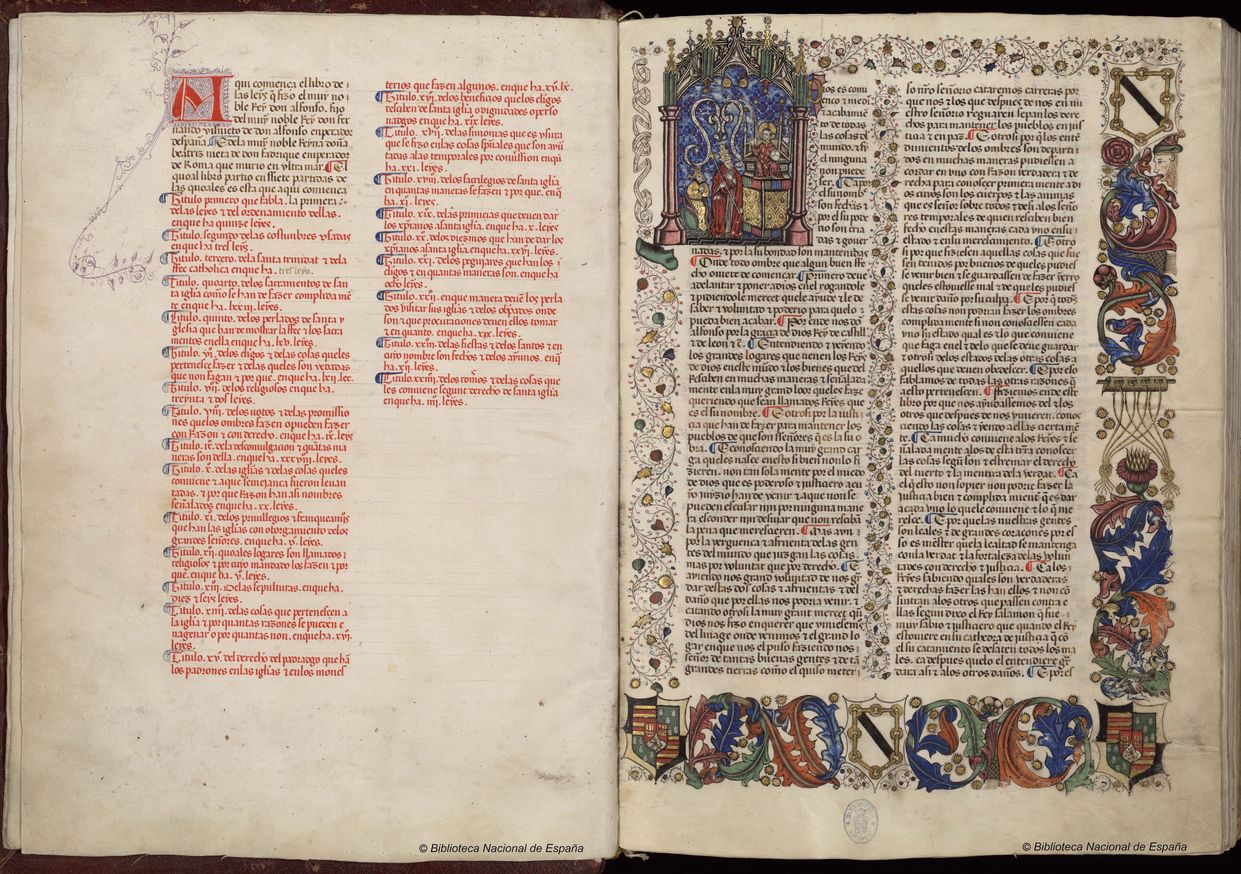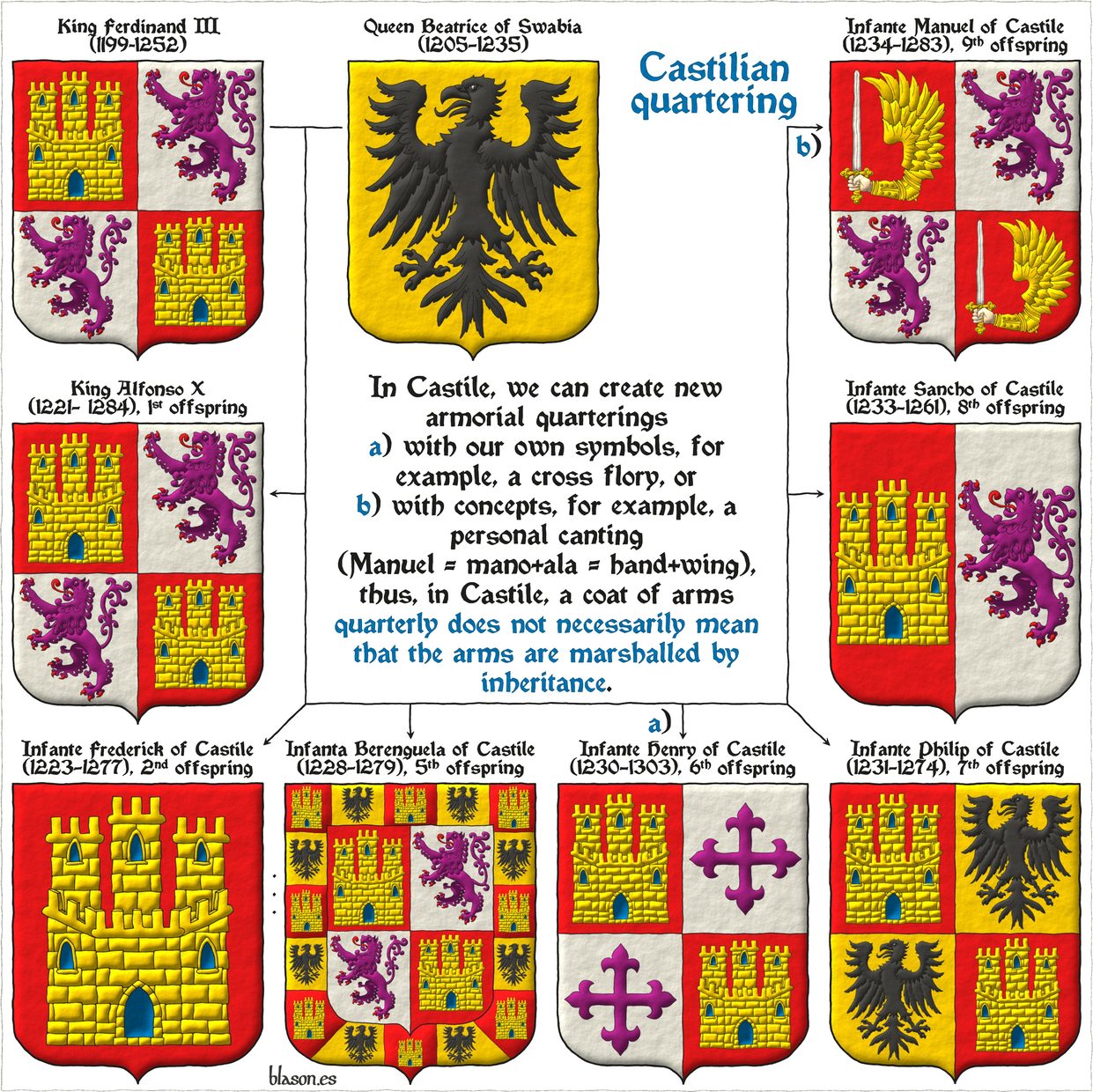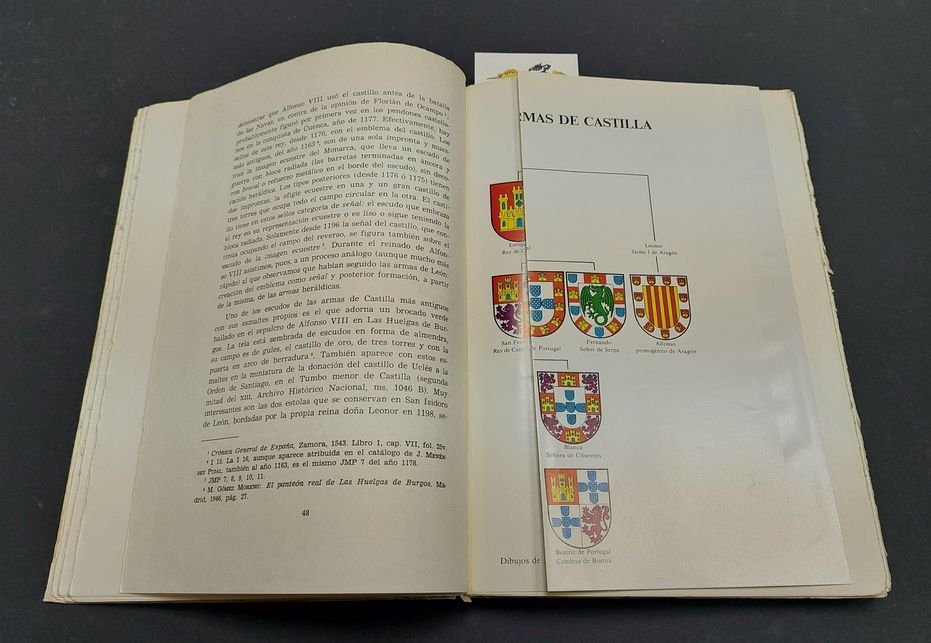Kingdom of Castile and Leon


![Ver [Alfonso X of Castile; 1265] en referencias bibliográficas. Libro abierto, hojas de plata, filo de oro, guardas de gules, tapas de sable.](../css/Libro.Bibliografia.png)
Alfonso X of Castile; 1265
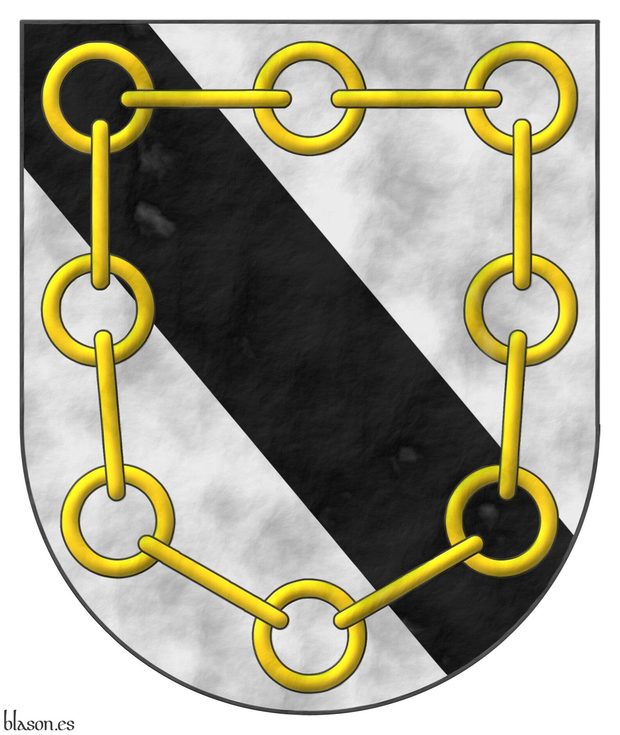
Alfonso X of Castile, The Wise, «The Seven-Part Code», its estimated completion year is 1265.
This is the copy I can consult, as it is available in the Hispanic Digital Library, it is a manuscript measuring 42 by 30 centimeters that once belonged to Álvaro de Zúñiga y Guzmán, first Duke of Arévalo, which later came into the possession of the Catholic Monarchs, initially Queen Isabella I of Castile, and after her death, King Ferdinand reclaimed it for the price of 5,251 maravedis. The original is housed in the National Library, in display case 4/6.
This copy, in addition to its numerous capital letters, has 8 illustrated pages, which according to its subsequent hand-numbering in pencil are:
- Page 6, among its illustrations can be seen 2 coats of arms of the Zúñiga family «Argent, a bend Sable, over all, a chain in orle Or», in this case formed by 16 links, 8 round and 8 more elongated placed in profile.
- Pages 106 and 191, on the latter can be seen a curious bishop-lizard climbing.
- Pages 294 and 331, on the 2nd at the bottom, a maiden is seen walking a monkey to relieve itself and to her right a fight of men with beast bodies.
- Page 379 and on its previous unnumbered page, and finally, on page 415 which begins with a tournament where the 2nd knight bears the ancient arms of France «Azure, semy of fleurs de lis Or».
The coat of arms that illustrates this bibliographic reference is that of Álvaro de Zúñiga y Guzmán. For the creation of his chain, I followed the illustration of his 2 coats of arms on the already mentioned page 6 of this manuscript.
It is one of my favorite manuscripts and, perhaps, the one with which I have created the most things.
Bibliographical reference of century XIII.
Classification: Castilian language, Manuscript and In color.
The author is Alfonso X of Castile.
The following article cites this bibliographic reference:
External resources:
- National Library of Spain.
- Indirect access to the Library of Congress of the United States of America.
- Direct access to the Library of Congress of the United States of America.
Internal resources: AlfonsoXDeCastilla1265.7Partidas.10642.pdf.

Alphonse X of Castile, open royal crown
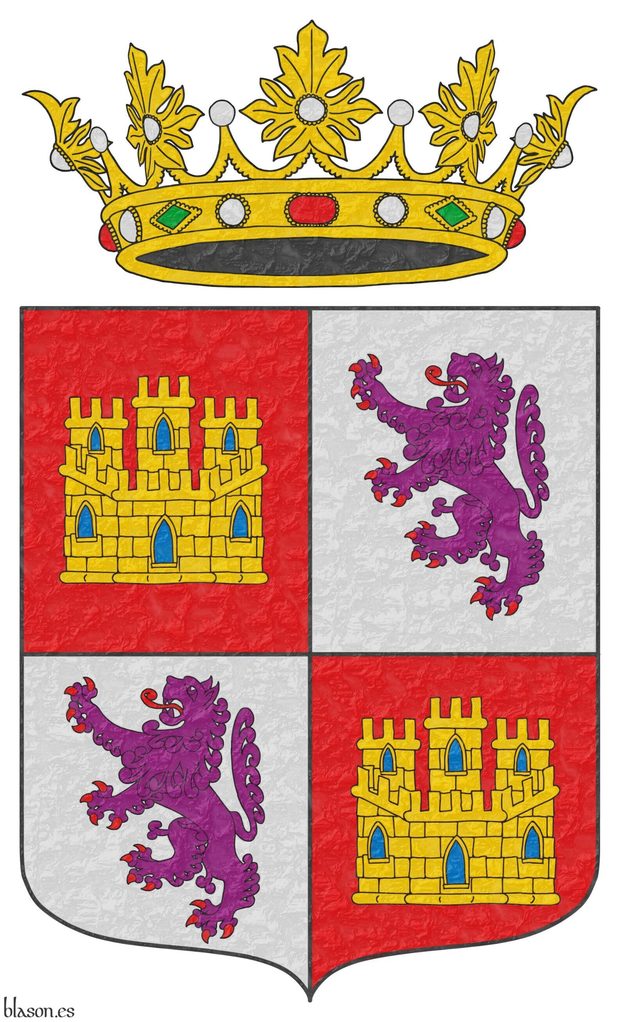
Escudo cuartelado: 1o y 4o de gules, un castillo de oro, aclarado de azur, mazonado de sable; 2o y 3o de plata, un león rampante de púrpura, armado y lampasado de gules. Timbrado de una corona real abierta.
Quarterly: 1 and 4 Gules, a castle triple towered Or, port and windows Azure, masoned Sable; 2 and 3 Argent, a lion rampant Purpure, armed and langued Gules. Crest: An open royal crown Or.
I emblazoned the coat of arms of the King with an external shape ending in an ogee arch, the field, castles, lions, and crown are outlined; and all have a crystal clear finishing.
Blazon keywords: Quarterly, Gules, Or, Azure, Sable, One, Castle, Port and windows, Masoned, Argent, Purpure, Lion, Rampant, Armed, Langued, Crest, Open royal crown and Crown.
Style keywords: Ogee, Plain tincture, Outlined in sable and Marmoreal.
Classification: Interpreted, Personal, Coat of arms and Kingdom of Castile and Leon.
Bearer: Alphonse X of Castile.


Berenguela of Castile, Infanta
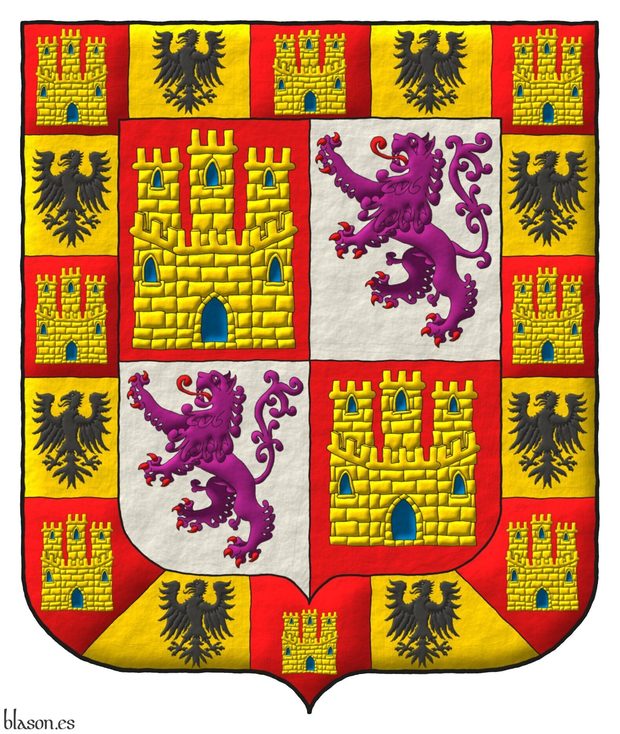
Quarterly: 1 and 4 Gules, a castle triple-towered Or, port and windows Azure, and masoned Sable; 2 and 3 Argent, a lion rampant Purpure, armed and langued Gules; a bordure compony of sixteen sections: eight Gules, a castle triple-towered Or, port and windows Azure, and masoned Sable, eight Or, an eagle displayed Sable.
Escudo cuartelado: 1o y 4o de gules, un castillo de oro, aclarado de azur, mazonado de sable; 2o y 3o de plata, un león rampante de púrpura, armado y lampasado de gules; una bordura componada de dieciseis compones: ocho de gules, un castillo de oro, aclarado de azur, mazonado de sable, ocho de oro, un águila de sable.
Coat of arms emblazoned by me, illuminated with lights and shadows, contoured in Sable, with an ogee outer contour and with a freehand finishing.
Coat of arms of the Infanta Berenguela of Castile, 1228–1279, 5th daughter of the King Ferdinand III of Castile, 1199-1252, and the Queen Beatrice of Swabia, 1205–1235. There are discrepancies regarding the year of her death, with sources suggesting either 1279 or 1288. She bore her father's arms with a bordure compony featuring the arms of Castile and those of her mother, from Swabia. [Menéndez Pidal de Navascués, F.; 1982; page 104 and illustration between pages 112 and 113] writes «We know of a seal of this infanta that displays in the field the royal quarterly, surrounded like a bordure by 4 castles and 4 eagles, alternating», and in the illustration he depicts the bordure with 8 castles and 8 eagles, which is the version I have interpreted. I am particularly fond of compony arms, and this one is, to me, among the most beautiful and quintessentially Castilian.
Blazon keywords: Gules, Or, Azure, Sable, Argent, Purpure, One, Sixteen, Eight, Quarterly, Castle, Triple-towered, Port and windows, Masoned, Lion, Rampant, Armed, Langued, Bordure, Compony and Eagle.
Style keywords: Outlined in sable, Illuminated, Ogee and Freehand.
Classification: Personal, Kingdom of Castile and Leon, Interpreted, Boa and Coat of arms.
Bearer: Berenguela of Castile, Infanta.


Cáceres, Province of
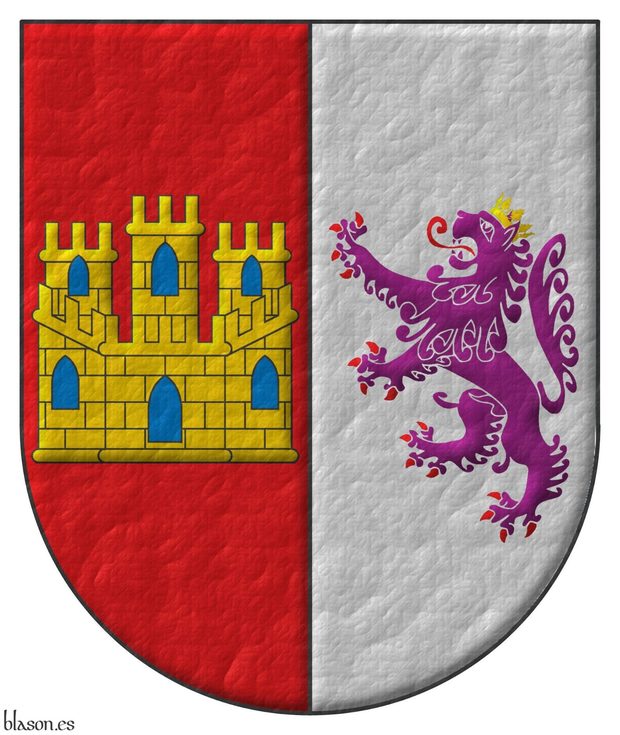
Party per pale: 1 Gules, a castle triple towered Or, port and windows Azure, masoned Sable; 2 Argent, a lion rampant Purpure, armed and langued Gules, crowned Or.
Escudo partido: 1o de gules, un castillo de oro, aclarado de azur, mazonado de sable; 2o de plata, un león rampante de púrpura, armado y lampasado de gules, coronado de oro.
Civic coat of arms interpreted by me as follows: the shield has a semicircular (round) base; the field, the castle and the lion are illuminated; the lion and its crown are outlined in the colour of the field; the open royal crown and the castle are outlined in Sable, in the case of the castle because it is masoned; and the whole has a canvas texture.
Blazon keywords: Party per pale, Argent, Purpure, Gules, Or, Azure, Castle, Lion, Port and windows, Masoned, Rampant, Armed, Langued, Crowned, Crown and Open royal crown.
Style keywords: Semi-circular, Illuminated and Fabric.
Classification: Interpreted, Civic, Coat of arms and Kingdom of Castile and Leon.
Bearer: Cáceres, Province of.


Castile and León
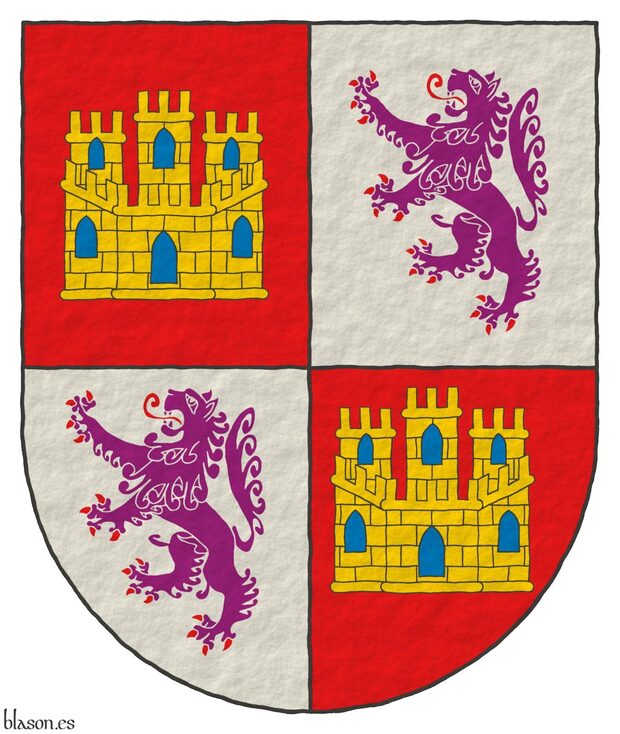
Quarterly: 1 and 4 Gules, a castle triple towered Or, port and windows Azure, masoned Sable; 2 and 3 Argent, a lion rampant Purpure, armed and langued Gules, crowned Or.
Escudo cuartelado: 1o y 4o de gules, un castillo de oro, aclarado de azur, mazonado de sable; 2o y 3o de plata, un león rampante de púrpura, armado y lampasado de gules, coronado de oro.
This coat of arms can be seen in [Bergshammars; 1440; page 2], in [Lutzelbourg, N. de; 1530; page 35] and in [Tewkesbury; 17th century; folio 25v].
Blazon keywords: Quarterly, Gules, Or, Azure, Sable, One, Castle, Port and windows, Masoned, Argent, Purpure, Lion, Rampant, Armed, Langued and Crowned.
Style keywords: Semi-circular and Plain tincture.
Classification: Interpreted, Civic, Coat of arms, Kingdom of Castile and Leon and Canting.
Bearer: Castile and León.


Central Military Region
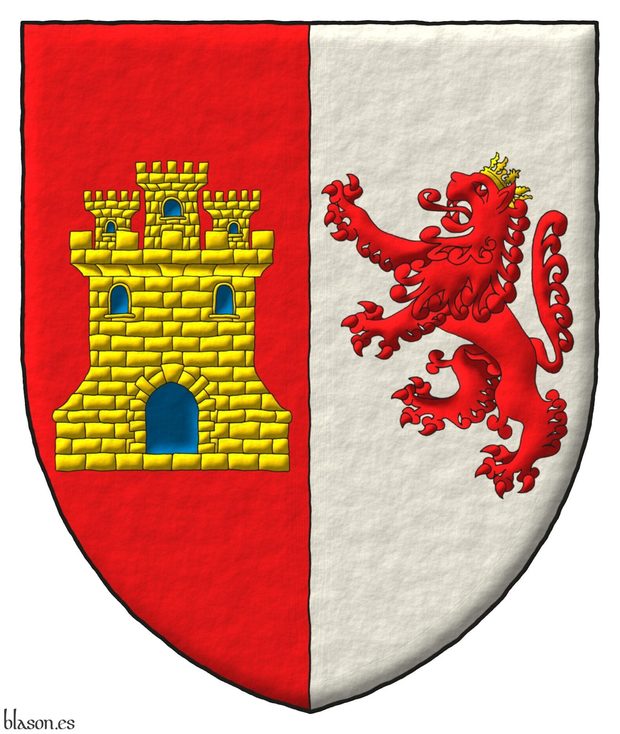
Party per pale: 1 Gules, a castle triple-towered Or, port and windows Azure, and masoned Sable; 2 Argent, a lion rampant Gules, crowned Or.
Coat of arms (1984-1997 and 1997-2002) of the former Central Military Region, where I serve. I interpreted now this coat of arms with a pointed shape. This kind of shape for this coat of arms are not usual.
Blazon keywords: Party per pale, Gules, One, Castle, Or, Port and windows, Azure, Masoned, Sable, Argent, Lion, Rampant and Crowned.
Style keywords: Pointed, Illuminated, Outlined in sable and Metal beaten.
Classification: Interpreted, Military, Army and Navy, Coat of arms and Kingdom of Castile and Leon.
Bearer: Central Military Region.


Ferdinand III of Castile
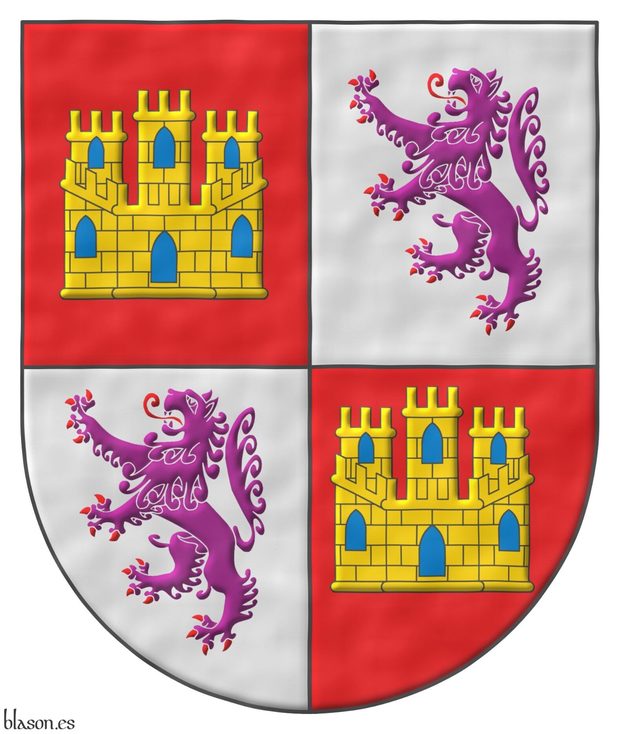
Son of Berenguela, Queen of Castile, and Alfonso IX, King of León.
Quarterly: 1 and 4 Gules, a castle triple towered Or, port and windows Azure, masoned Sable; 2 and 3 Argent, a lion rampant Purpure, armed and langued Gules.
Escudo cuartelado: 1o y 4o de gules, un castillo de oro, aclarado de azur, mazonado de sable; 2o y 3o de plata, un león rampante de púrpura, armado y lampasado de gules.
Arms of King Ferdinand III of Castile, as interpreted by me, with the following characteristics: the shield’s shape is rounded; the field, the two castles, and the two lions have been illuminated; and the whole composition features a watercolor finish.
It is with King Ferdinand III the Saint of Castile when «the emblematic system reaches its highest degree of perfection, acquiring two characteristics: realism, which becomes a hallmark of Spanish heraldry,... and the tendency to combine coats of arms» with the appearance of quarterly divisions replacing the cadency marks used in the rest of Europe [Valverde Ogallar, P. B.; 2001; page 100].
Shield in flat ink and illuminated metallic finish
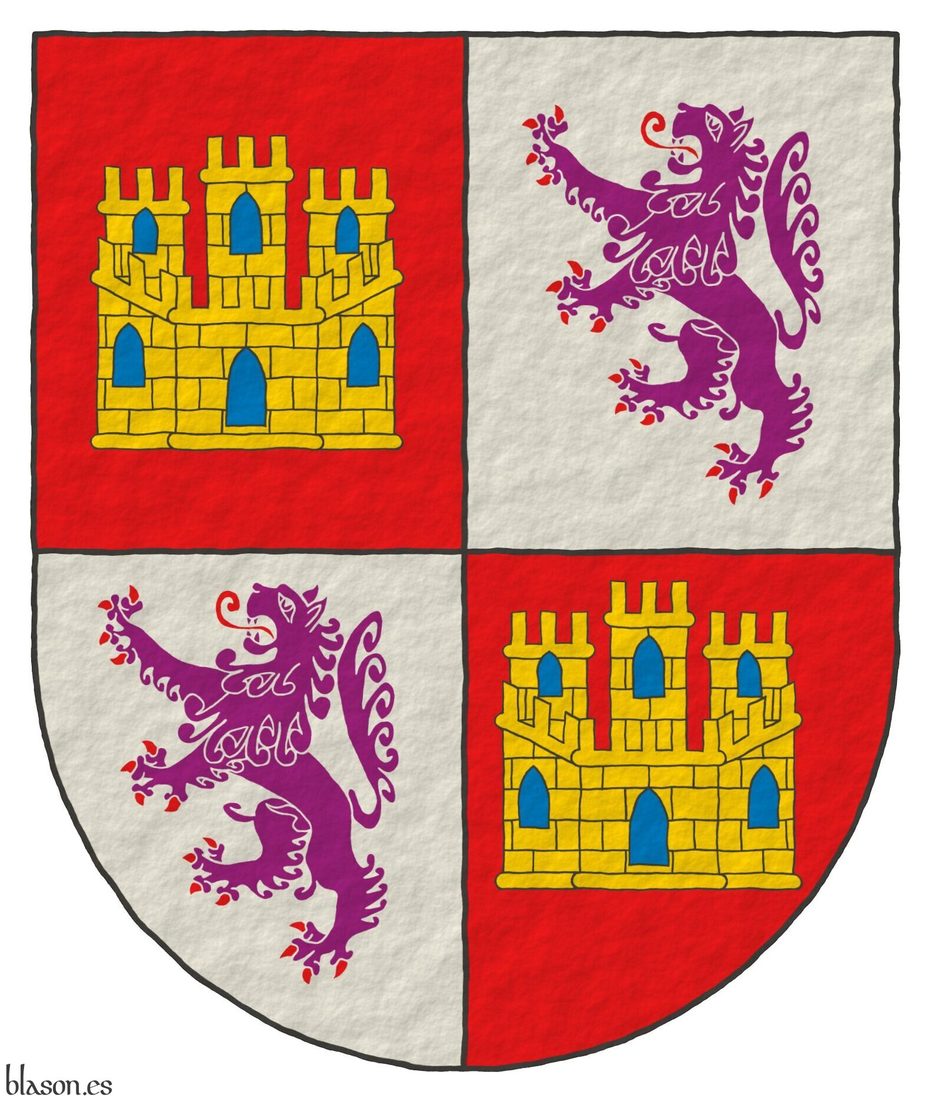
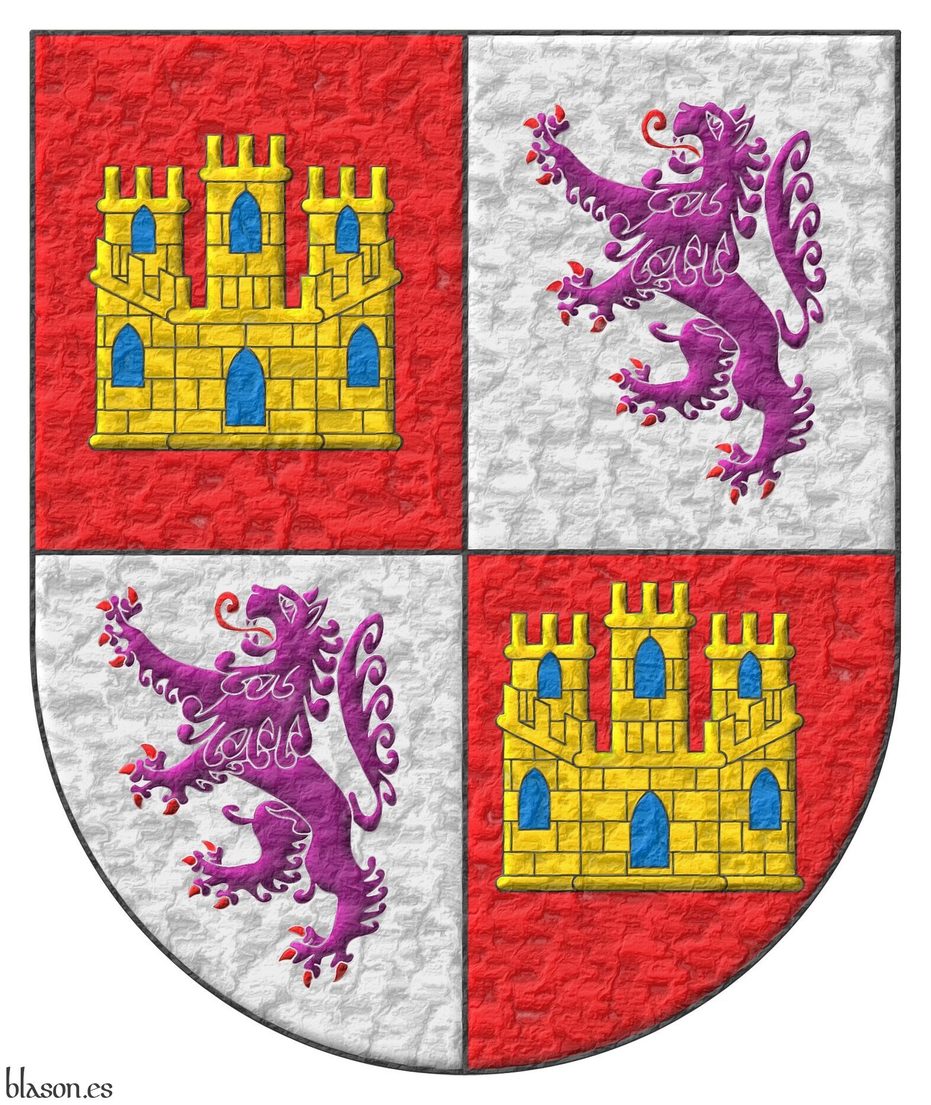
Design of a heraldic document
Blazon keywords: Quarterly, Gules, Or, Azure, Sable, One, Castle, Port and windows, Masoned, Argent, Purpure, Lion, Rampant, Armed and Langued.
Style keywords: Semi-circular, Illuminated and Watercolor.
Classification: Interpreted, Personal, Coat of arms and Kingdom of Castile and Leon.
Bearer: Ferdinand III of Castile.


Fernández de Córdoba y Carrillo, Diego
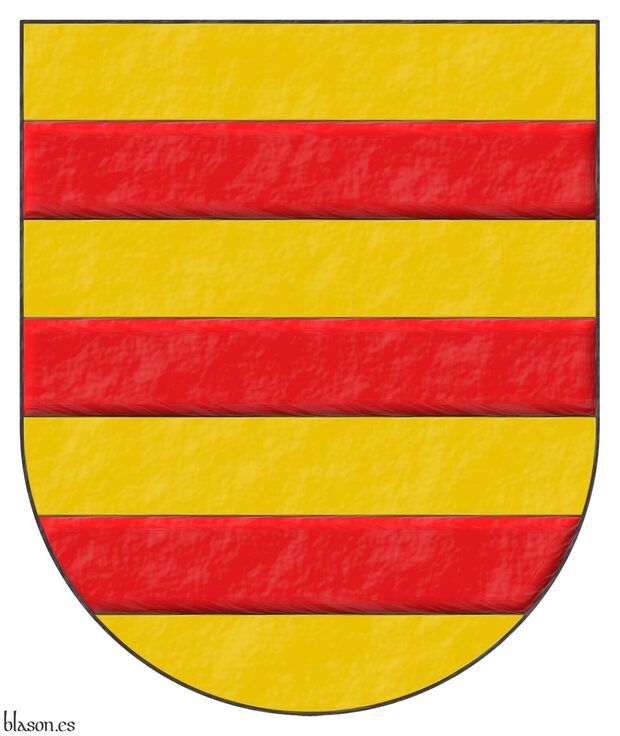
Marshal of Castile, first Lord of Baena and plenipotentiary ambassador to the court of Portugal (1355–1435).
Or, three fesses Gules.
Escudo de oro, tres fajas de gules.
Coat of arms del que fue mariscal de Castilla interpreted as follows: the shield has a semicircular (round) base; the field is illuminated in flat metal Or; its three fesses illuminated in Gules y outlined in Sable; y el conjunto con un plastered finish.
He served under the kings John I of Castile, Henry III of Castile, and John II of Castile.
These three bars of the Fernández de Córdoba lineage are found, for example, in the first quarter of the coat of arms of Gonzalo Fernández de Córdoba y Enríquez de Aguilar, known as *El Gran Capitán*.
Blazon keywords: Without divisions, Or, Fess and Gules.
Style keywords: Illuminated, Outlined in sable, Semi-circular and Gesso.
Classification: Interpreted, Personal, Coat of arms and Kingdom of Castile and Leon.
Bearer: Fernández de Córdoba y Carrillo, Diego.
Blazon equivalent to: Berry of Molland.


Henry of Castile, Infante
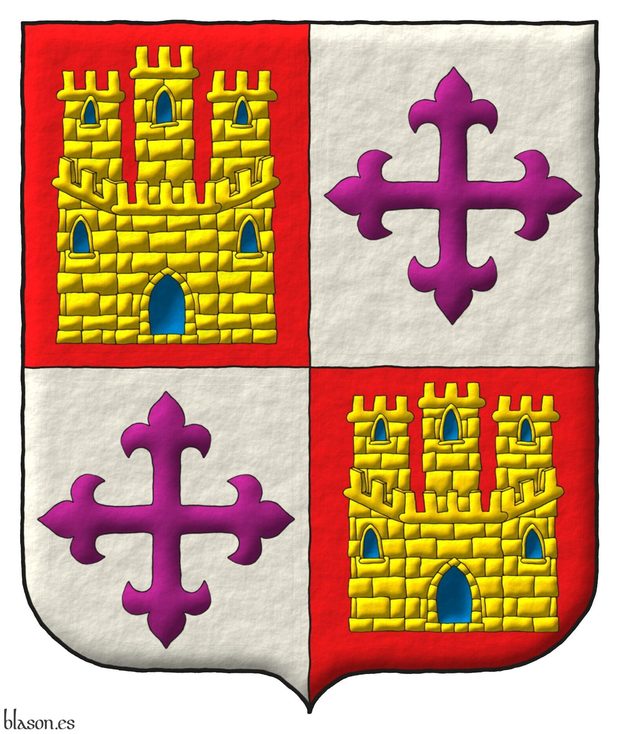
Quarterly: 1 and 4 Gules, a castle triple-towered Or, port and windows Azure, and masoned Sable; 2 and 3 Argent, a cross flory Purpure.
Escudo cuartelado: 1o y 4o de gules, un castillo de oro, aclarado de azur, mazonado de sable; 2o y 3o de plata, una cruz flordelisada de púrpura.
Arms depicted by me, highlighted with lights and shadows, outlined in Sable, with an ogee external shape and with a freehand finishing.
Coat of arms of the Infante Henry of Castile, 1230–1303, 6th offspring of the King Ferdinand III of Castile, 1199-1252, and the Queen Beatrice of Swabia, 1205–1235. He bore his father's arms, replacing the lion Purpure of the Kingdom of León with a cross flory Purpure, likely due to his close association with the Order of Calatrava, whose emblem is a cross flory Gules. However, he retained the metal Argent field in the 2nd and 3rd quarters and the lion's purple color, suggesting this was more of a conceptual change than a quartering by alliance with the Order of Calatrava.
Blazon keywords: Gules, Or, Azure, Sable, Argent, Purpure, One, Quarterly, Castle, Triple-towered, Port and windows, Masoned, Cross flory and Cross couped.
Style keywords: Outlined in sable, Illuminated, Ogee and Freehand.
Classification: Personal, Kingdom of Castile and Leon, Interpreted, Boa and Coat of arms.
Bearer: Henry of Castile, Infante.


Infante Manuel of Castile, schema 3x4
In Castile, a coat of arms quarterly does not necessarily signify inheritance. This schema illustrates two practices: a) Quarterings can represent the mother in the 1st and 4th quarters and the father in the 2nd and 3rd, highlighting the prominence given to the maternal line by placing it in the most visible quarters. b) Quarterings can also include personal symbols and concepts, like canting arms, for example, «Manuel» =«mano» + «ala» = «hand» + «wing», combined with ancestral arms. This flexibility reflects Castilian heraldic traditions, where arms are not strictly marshalled by inheritance. The inclusion of maternal arms in the 1st and 4th quarters highlights how Castilian heraldry often elevates maternal heritage, differing from some other heraldic traditions. The previous commentary emphasizes the creative freedom in Castile, where quartering could incorporate personal symbols or canting arms without the constraints of inheritance or dominium. This flexibility aligns with Castilian culture, allowing heraldry to reflect personal identity, not just dynastic ties. Notably, the arms of Infante Enrique's use of a cross flory demonstrates this creative freedom, showcasing the ability to innovate within heraldry even in royal contexts. While this might seem unconventional compared to other heraldic systems, it is deeply rooted in Castilian tradition. All coats of arms in this schema have been emblazoned by me.
Blazon keywords: Argent, Purpure, Gules, Or, Azure, Sable, One, Quarterly, Lion, Rampant, Armed, Langued, Castle, Triple-towered, Port and windows, Masoned, Bordure, Compony, Eagle, Cross flory, Cross couped, Party per pale, Hand, Arm, Vambraced, Embowed, Winged, Sword, Point upwards and Hilted.
Style keywords: Outlined in sable, Illuminated and Ogee.
Classification: Personal, Kingdom of Castile and Leon, Interpreted, Design rationale, Schema, Boa and Coat of arms.
Bearer: Manuel of Castile, Infante.


![Ver [Menéndez Pidal de Navascués, F.; 1982] en referencias bibliográficas. Libro abierto, hojas de plata, filo de oro, guardas de gules, tapas de sable.](../css/Libro.Bibliografia.png)
Menéndez Pidal de Navascués, F.; 1982
Faustino Menéndez Pidal de Navascués, «Medieval Spanish Heraldry I: The Royal House of Leon and Castile», illustrations by Jaime Bugallal y Vela, edited by the Salazar and Castro Institute, (C. S. I. C. Higher Center for Scientific Research), published by Hidalguía, 271 pages, size 24 x 17 cm, includes color plates, Legal deposit M. 22.165-1982, ISBN 84-00-05150-5, printed by Imprenta Sáez, Madrid, 1982.
Index
- Introduction, page 11.
- Abbreviations, page 22.
- Alfonso VII, page 23.
- Fernando II, page 39.
- Alfonso VIII, page 47.
- The spread of the arms of Castile, schema between pages 48 and 47.
- Alfonso IX, page 71.
- Fernando III, page 87.
- Alfonso X, page 109.
- Origins of differentiated arms, schema between pages 48 and 47.
- Sancho IV, page 129.
- Fernando IV, page 139.
- Alfonso XI, page 141.
- Pedro I, page 157.
- Henry II, page 165.
- John I, page 177.
- Henry III, page 185.
- John II, page 189.
- Henry IV, page 195.
- Isabella and Ferdinand, page 199.
- Children of the Catholic Monarchs, page 207.
- Evolution of the arms of Spain, page 213.
- The House of Austria, page 239.
- The Houses of Two Sicilies and Parma, page 241.
- Arms of Castile and Leon outside the Royal House, page 243.
- Index nominum, page 265.
- Index rerum, page 271.
Bibliographical reference of century XX.
Classification: Black and white with color plates and Castilian language.
The author is Menéndez Pidal de Navascués, Faustino.
Bibliographical reference mentioned in the following article:
Internal resources: Physical book in paper.


Philip of Castile, Infante
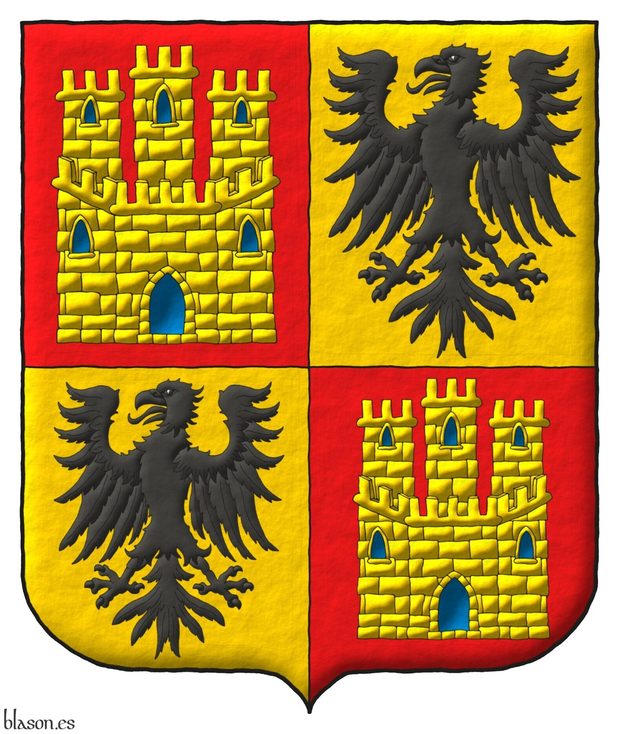
Quarterly: 1 and 4 Gules, a castle triple-towered Or, port and windows Azure, and masoned Sable; 2 and 3 Or, an eagle displayed Sable.
Escudo cuartelado: 1o y 4o de gules, un castillo de oro, aclarado de azur, mazonado de sable; 2o y 3o de oro, un águila de sable.
Arms painted by me, illuminated with lights and shadows, outlined in Sable, with an ogee external shape and with a freehand finish.
Coat of arms of the Infante Philip of Castile, 1231–1274, 7th offspring of the King Ferdinand III of Castile, 1199-1252, and the Queen Beatrice of Swabia, 1205–1235. This coat of arms has been emblazoned by me and can be consulted in [Messía de la Cerda y Pita, L.; 1990; page 146] with the field Or in the 2nd and 3rd quarters. He bears a quarterly shield combining the first quarter of his father’s arms, Castile, with his mother’s arms. Among all his siblings, he is the one who most closely combines the arms of both parents.
Blazon keywords: Gules, Or, Azure, Sable, One, Quarterly, Castle, Triple-towered, Port and windows, Masoned and Eagle.
Style keywords: Outlined in sable, Illuminated, Ogee and Freehand.
Classification: Personal, Kingdom of Castile and Leon, Interpreted, Boa and Coat of arms.
Bearer: Philip of Castile, Infante.


Sancho IV of Castile, open royal crown
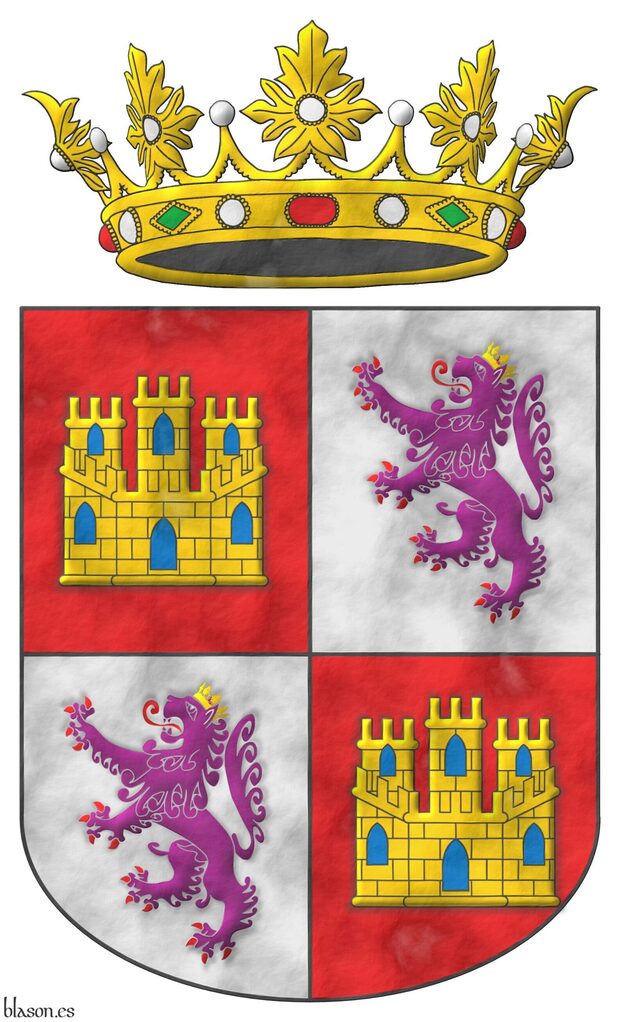
Son of Alfonso X of Castile and Violant of Aragon.
Quarterly: 1 and 4 Gules, a castle triple towered Or, port and windows Azure, masoned Sable; 2 and 3 Argent, a lion rampant Purpure, armed and langued Gules, crowned Or. Crest: An open royal crown Or.
Escudo cuartelado: 1o y 4o de gules, un castillo de oro, aclarado de azur, mazonado de sable; 2o y 3o de plata, un león rampante de púrpura, armado y lampasado de gules, coronado de oro. Timbrado de una corona real abierta.
Arms of the king interpreted by me as follows: the shield of arms has a rounded (semicircular) base; the quarters are in flat tinctures Argent and Gules; the castles, lions and crown are illuminated; the castles and lions are shaded; and the whole has a parchment finish.
Blazon keywords: Quarterly, Gules, Or, Azure, Sable, One, Castle, Port and windows, Masoned, Argent, Purpure, Lion, Rampant, Armed, Langued, Crowned, Crest, Open royal crown and Crown.
Style keywords: Rounded, Illuminated and Parchment.
Classification: Interpreted, Personal, Coat of arms and Kingdom of Castile and Leon.
Bearer: Sancho IV of Castile.


Sancho of Castile, Infante
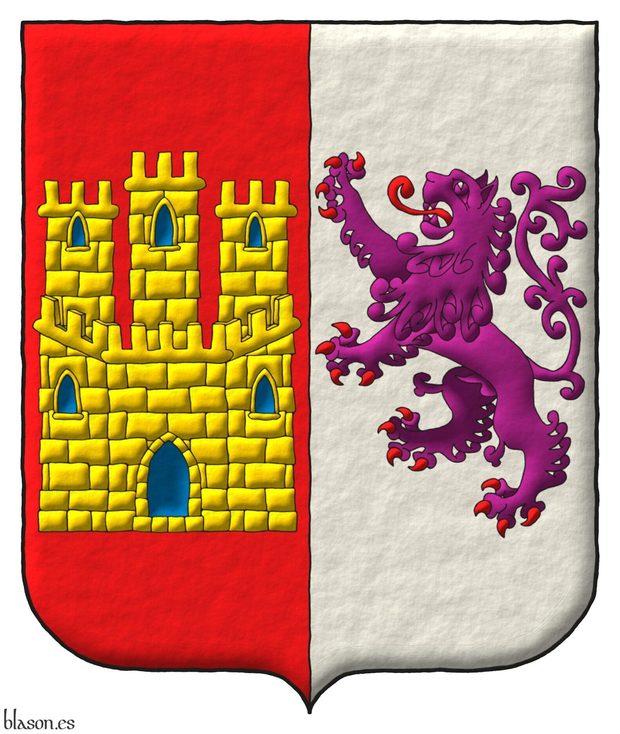
Party per pale: 1 Gules, a castle triple-towered Or, port and windows Azure, and masoned Sable; 2 Argent, a lion rampant Purpure, armed and langued Gules.
Escudo partido: 1o de gules, un castillo de oro, aclarado de azur, mazonado de sable; 2o de plata, un león rampante de púrpura, armado y lampasado de gules.
Arms emblazoned by me, highlighted with lights and shadows, contoured in Sable, with an ogee outer contour and with a freehand finish.
Coat of arms of the Infante Sancho of Castile, 1233–1261, 8th offspring of the King Ferdinand III of Castile, 1199-1252, and the Queen Beatrice of Swabia, 1205–1235. Unlike his siblings, he does not use a quarterly shield but rather impaled arms of Castile and Leon.
Blazon keywords: Gules, Or, Azure, Sable, Argent, Purpure, One, Party per pale, Castle, Triple-towered, Port and windows, Masoned, Lion, Rampant, Armed and Langued.
Style keywords: Outlined in sable, Illuminated, Ogee and Freehand.
Classification: Personal, Kingdom of Castile and Leon, Interpreted, Boa and Coat of arms.
Bearer: Sancho of Castile, Infante.


![Ver [Serra i Rosell, P.; 2016] en referencias bibliográficas. Libro abierto, hojas de plata, filo de oro, guardas de gules, tapas de sable.](../css/Libro.Bibliografia.png)
Serra i Rosell, P.; 2016
Pedro Serra i Rosell, architect and Vice President of the SCGHSVN, «Transmission of armorial bearings in the Kingdom of Castile in the 13th century. The arms of Don Enrique de Castilla, son of Fernando III the Saint.», published in Paratge, quaderns d'estudis de genealogia, heràldica, sigil·lografia i nobiliària, published by the Societat Catalana de Genealogia, Heràldica, Sigil·lografia, Vexil·lologia i Nobiliària, SCGHSVN, pages 187-192, issue 29, ISSN 1130-3395, Sant Cugat del Vallès, 2016,
Bibliographical reference of century XXI.
Classification: Article, Castilian language and Black and white and color illustrations.
The author is Serra i Rosell, Pedro.
Internal resources: SerraiRosellP2016.TransmisionCastilla.pdf PDF Format.
-
Language
-
Categories of heraldry
-
Divisions of the field
- Without divisions
- Party per pale
- Party per fess
- Party per bend
- Party per bend sinister
- Tierce
- Tierce sinister
- Tierced per pale
- Tierced per fess
- Tierced per bend
- Tierced pallwise inverted
- Quarterly
- Quarterly per saltire
- Gyronny
- Party per fess, the chief per pale
- Party per pale, the sinister per fess
- Party per fess, the base per pale
- Party per pale, the dexter per fess
- Chapé
- Chaussé
- Embrassé
- Contre-embrassé
- Party per chevron
- Enté
- Enté en point
- Flanched
-
Metals
-
Colours
-
Furs
-
Other tinctures
-
Ordinaries and sub-ordinaries
-
Diminutives of the ordinaries
-
Geometric charges
-
Composite ordinaries
-
Inanimate charges from Nature
Atom, Crescent, Diamond, Emerald, Estoile, Increscent, Lightning flash, Moon, Mount, Mullet, Mullet of four points, Orbital, Plough of Ursa Major, Rainbow, Ray of the sun, River, Sea, Snowflake, Sun, Sun in splendour, Sun of May, Trimount and Water.
-
Vegetal charges from Nature
Acorn, Apple, Apple tree, Ash, Bluebonnet, Camellia, Chrysanthemum, Cinquefoil, Cornflower, Dogwood flower, Double rose, Elm, Fleur de lis, Flower, Holm oak, Hop cone, Kapok tree, Laurel, Lily, Linden, Lotus flower, Madonna lily, Oak, Olive tree, Palm tree, Pomegranate, Poplar leaf, Rose, Shamrock, Sunflower, Thistle, Tree, Tulip, Vine and Wheat.
-
Animal charges from Nature
Badger, Bald eagle, Barbel, Barn owl, Bear, Beaver, Beetle, Bighorn sheep, Blackbird, Boar, Brach hound, Bull, Doe, Dog, Dolphin, Dove, Eagle, Elephant, Falcon, Fish, Flame, Fly, Fox, Frog, Goat, Goldfinch, Goose, Heron, Horse, Hummingbird, Jaguar, Lark, Leopard, Lion, Lion passant, Lion rampant guardant, Lioness, Lynx, Male figure, Martlet, Merino ram, Owl, Panther, Parrot, Peacock, Pelican, Pelican in her piety, Puffin, Quetzal, Raven, Roe deer, Rooster, Savage, Seagull, Serpent, She-wolf, Stag, Starling, Talbot, Tyger, Vulture, Warren hound and Wolf.
-
Parts of natural charges
Arm, Beak, Branch, Caboshed, Chest, Claw, Covert, Dorsal fin, Eagle claw, Ermine spot, Escallop, Feather, Foot (palmiped), Foreleg, Forepaw, Hand, Head, Heart, Hoof, Leaf, Neck, Ostrich feather, Palm frond, Paw, Roe deers' attires, Shoulder, Sprig, Stags' attires, Stem, Swallow-tail, Tail, Tail addorsed, Tail fin, Talon, Tooth, Trunk, Trunk (elephant), Two hands clasped, Two wings in vol, Udder, Wheat spike, Wing and Wrist.
-
Artificial charges
Ace of spades, Anchor, Anvil, Arch, Arm vambraced, Armillary sphere, Arrow, Axe, Bell, Bell tower, Beret, Bonfire, Book, Bookmark, Bow, Bridge, Broken, Buckle, Cannon, Cannon dismounted, Cannon port, Canopy roof, Carbuncle, Castle, Celtic Trinity knot, Chain, Chess rooks, Church, Clarion, Clay pot, Closed book, Club, Comb, Compass rose, Conductor's baton, Cord, Covered cup, Crozier, Crucible, Cuffed, Cup, Cyclamor, Dagger, Double vajra, Drum, Ecclesiastical cap, Fanon, Federschwert, Fleam, Four crescents joined millsailwise, Galician granary, Garb, Gauntlet, Geometric solid, Grenade, Halberd, Hammer, Harp, Host, Hourglass, Key, Key ward, Knight, Knot, Lantern, Letter, Line, Loincloth, Menorah, Millrind, Millstone, Millwheel, Monstrance, Mortar, Mullet of six points pierced, Nail, Non-classic artifact, Norman ship, Number, Oar, Oil lamp, Open book, Page, Pair of scales, Parchment, Pestle, Piano, Plough share, Polish winged hussar, Port, Portcullis, Potent, Quill, Ribbon, Rosette of acanthus leaves, Sabre, Sackbut, Sail, Scroll, Scythe, Sheaf of tobacco, Ship, Skirt, Spear, Spear's head, Stairway, Star of David, Step, Sword, Symbol, Tetrahedron, Torch, Tower, Trident, Trumpet, Turret, Two-handed sword, Wagon-wheel, Water-bouget, Wheel, Winnowing fan and With a turret.
-
Immaterial charges
Angel, Archangel, Basilisk, Dragon, Dragon's head, Garuda, Golden fleece, Griffin, Heart enflamed, Mermaid, Our Lady of Mercy, Ouroboros, Paschal lamb, Pegasus, Phoenix, Sacred Heart of Jesus, Saint George, Sea-griffin, Trinity, Triton, Unicorn, Winged hand and Wyvern.
-
External elements
-
Heraldic creations
-
References
-
Formats
-
Keywords on this page
Port and windows, Watercolor, Winged, Alphonse X of Castile, Point upwards, Parchment, Pointed, Armed, Vambraced, Article, Azure, Bibliography, Boa, Bordure, Castle, Crest, Compony, Ogee, Crown, Open royal crown, Crowned, Cross flory, Cross couped, Quarterly, Triple-towered, Outlined in sable, Coat of arms, Personal, Gules, Illuminated, Interpreted, Langued, Castilian language, Lion, Masoned, Semi-circular, Or, Party per pale, Argent, Without divisions, Civic, Purpure, Rampant, Kingdom of Castile and Leon, Sable, Plain tincture, Freehand, One and Eagle.

